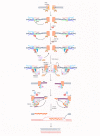BRCA Mutations and Fertility Preservation
- PMID: 38203374
- PMCID: PMC10778779
- DOI: 10.3390/ijms25010204
BRCA Mutations and Fertility Preservation
Abstract
Hereditary cancers mostly affect the adolescent and young adult population (AYA) at reproductive age. Mutations in BReast CAncer (BRCA) genes are responsible for the majority of cases of hereditary breast and ovarian cancer. BRCA1 and BRCA2 act as tumor suppressor genes as they are key regulators of DNA repair through homologous recombination. Evidence of the accumulation of DNA double-strand break has been reported in aging oocytes, while BRCA expression decreases, leading to the hypothesis that BRCA mutation may impact fertility. Moreover, patients exposed to anticancer treatments are at higher risk of fertility-related issues, and BRCA mutations could exacerbate the treatment-induced depletion of the ovarian reserve. In this review, we summarized the functions of both genes and reported the current knowledge on the impact of BRCA mutations on ovarian ageing, premature ovarian insufficiency, female fertility preservation strategies and insights about male infertility. Altogether, this review provides relevant up-to-date information on the impact of BRCA1/2 mutations on fertility. Notably, BRCA-mutated patients should be adequately counselled for fertility preservation strategies, considering their higher sensitivity to chemotherapy gonadotoxic effects.
Keywords: BRCA; DNA damage; breast cancer; chemotherapy; fertility preservation; ovarian aging.
Conflict of interest statement
I.D. reports research grants from Roche, speaker honoraria from Ferring, Novartis and travel grant from Theramex, Ferring outside the present work. J.D.N. and M.D. have no conflict of interest to report.
Figures


References
-
- Breast Cancer. [(accessed on 29 August 2023)]. Available online: https://www.europadonna.org/breast-cancer/
-
- Breast Cancer Facts and Statistics. 2023. [(accessed on 29 August 2023)]. Available online: https://www.breastcancer.org/facts-statistics.
-
- European Cancer Information System . European Commission Breast Cancer Burden in EU-27. European Commission; Brussel, Belgium: 2020.
-
- Breast Cancer in Young Women (Under 40) [(accessed on 29 August 2023)]. Available online: https://my.clevelandclinic.org/health/articles/16805-breast-cancer-in-yo....
Publication types
MeSH terms
Substances
Grants and funding
LinkOut - more resources
Full Text Sources
Medical
Miscellaneous

